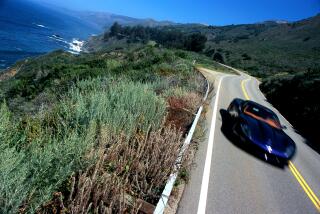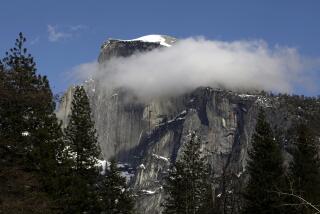50th Birthday Fete Readied for Alaska Highway : Frontier: Building of the road in just eight months in 1942 rated among great engineering feats of this century.
- Share via
WHITEHORSE, Canada — Americans and Canadians in the far north are gearing up this winter for a season of nostalgia to mark the 50th anniversary of the building of the Alaska Highway.
Organizers say more than 100 special events are planned along the 1,500-mile road, which transformed an isolated frontier land of myth and mystery into a modern adventure-travel playground.
Military historians have questioned the strategic need for ramming a road through a wilderness, all of it in daunting territory and most of it unexplored even by native hunters.
But most observers agree that the building of the Alaska Highway in just eight months in 1942 is among the great engineering feats of the 20th Century.
Living in tents, more than 10,000 soldiers from seven regiments of the U.S. Army Corps of Engineers worked feverishly between March and November in temperatures that plummeted to record lows of more than 70 degrees below zero.
Fifty years later, military and civilian veterans of World War II will return to take part in a series of celebrations, according to the Yukon Anniversaries Commission, which is helping to organize the party.
They will be joined by an assortment of thrill-seekers in vintage vehicles and planes, mule trains, horse-drawn wagons, dog sleds, snowmobiles, float planes and motorcycles, commission spokesman Ken Spotswood said.
“We don’t know how many are coming. Our hope is that they don’t all come at once,” he said.
Spotswood said it was the fear of a Japanese invasion following the bombing of Pearl Harbor on Dec. 7, 1941, that drove the U.S. and Canadian governments to build the highway.
The only direct land route from the lower U.S. states to Alaska, it was to connect a chain of airfields stretching from the American prairies to Ladd Field near Fairbanks, Alaska.
Canada supplied the right-of-way from Dawson Creek in northern British Columbia to Delta Junction, Alaska, through Canada’s Yukon territory, best known for the turn-of-the-century Klondike gold rush.
The hardships suffered by the original highway crews were legendary. Moss bogs swallowed bulldozers, overflowing streams ripped out bridges and soldiers literally froze to death.
Experienced American engineers were baffled by the permafrost. They would finish a stretch of dry road one day only to find it a sunken mudhole the next.
For some northern residents, it was the best of times.
“I think it was the best thing ever happened. Look at all the automobiles we have up here. When I came here (in 1935) there was only two,” said former highway camp waitress Edie Thomas, now 81.
Thomas recalled fondly the weekly dances with U.S. troops.
“There were no wallflowers there. The girls were all taken up. There were a lot of broken hearts when (the military) left,” she said.
For others, it was the worst of times. Scores of Indians died from diseases introduced by the construction workers.
In the winter of 1942-1943, the native village of Teslin suffered eight successive epidemics of diseases ranging from mumps to meningitis, says University of Victoria history professor Ken Coates.
“Dozens died. Half of the native children in that area under the age of 5 died in that one year,” Coates said.
Black soldiers comprising three of the U.S. Army regiments also suffered terribly, mainly because they were from the South and had never experienced a real winter, he said.
Yukon native Harold Chambers, whose father was an army guide, remembers how as a 12-year-old he saw a black corpse in a truck beside the highway.
“He was a Negro and he froze to death. He ran out of gas and he stopped and that was it,” said Chambers, 61.
Blacks also suffered racial discrimination, says Yukoner Orval Couch, who worked as a highway truck repair foreman.
“I’d see groups of (white) GIs walking up the street there in Dawson Creek and they’d meet three or four Negroes and the Negroes would have to get off the sidewalk and walk on the street. The Negroes got all the dirty jobs,” said Couch, 80.
Couch said Canadian crews also were worked to the bone, for a fraction of the pay of their American counterparts.
“I worked seven days a week, 13 hours a day. You might as well have been in a concentration camp. There was no overtime. We got paid little better than a third of what the Americans got,” he said.
Many Yukoners preferred to become bootleggers. They bought Canadian rye whiskey from the local liquor store and sold it on the highway for as much as a 1,000% profit.
The United States officially turned over operation and maintenance of the road to the Canadian military in 1946.
“The road was only opened to public travel in 1948 and even then it was rough, unreliable and subject to frequent closures,” historian Coates said.
Major reconstruction did not start until the mid-1960s. But the road now is paved along virtually all its length and stickers declaring “I Survived the Alaska Highway,” which were once common, are now collectors’ items.
Many adventure-seekers still miss the blind corners and wreck-strewn ditches of the romantic old road, Coates said.
“Some tourists are upset about the highway being paved. They would just as soon have it a rough frontier road.”
More to Read
Sign up for Essential California
The most important California stories and recommendations in your inbox every morning.
You may occasionally receive promotional content from the Los Angeles Times.












